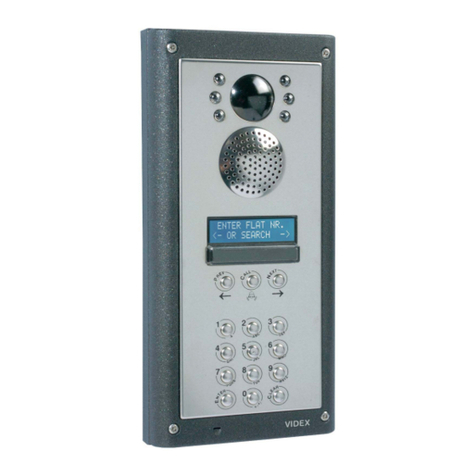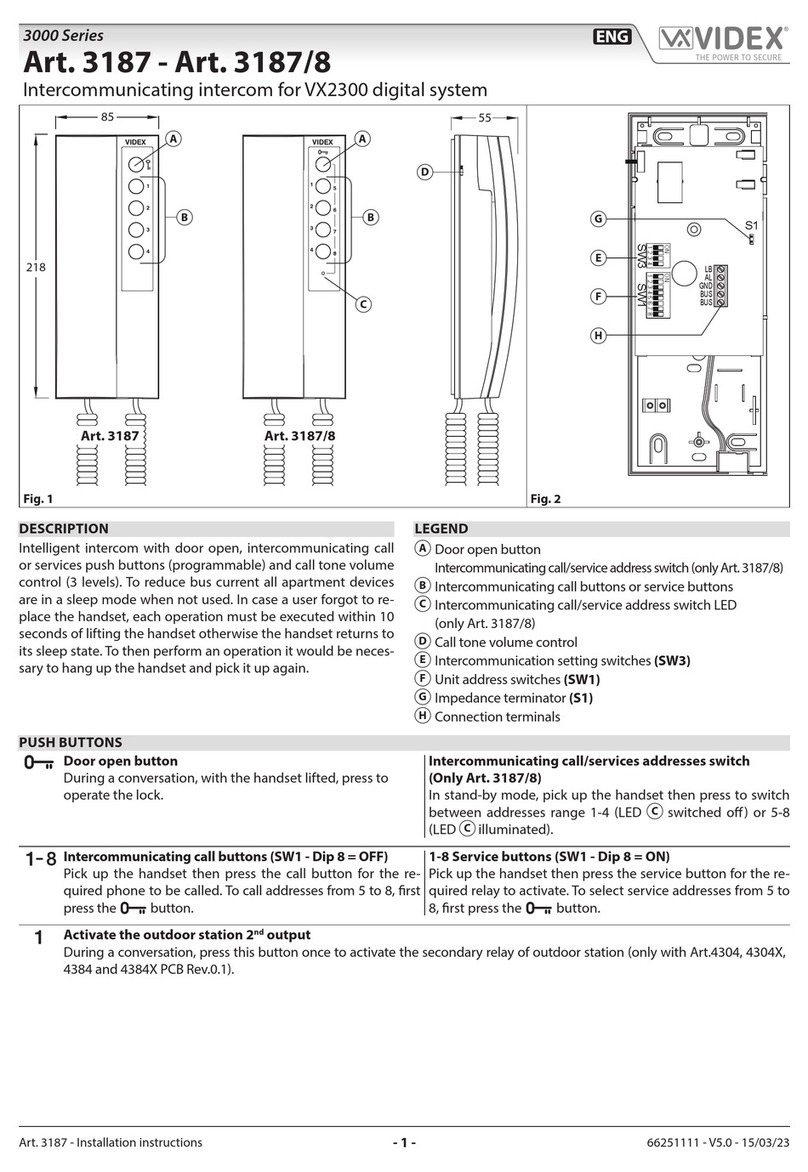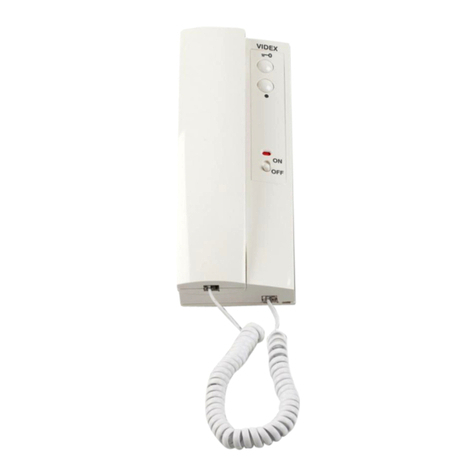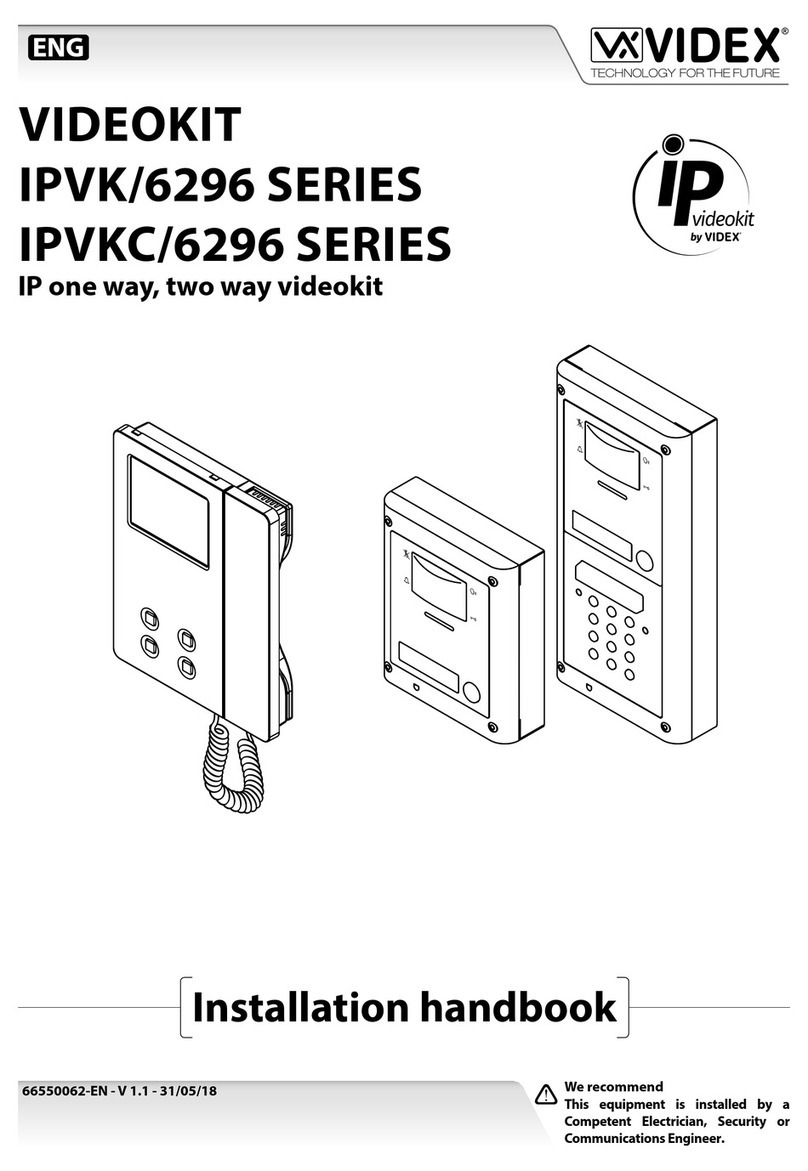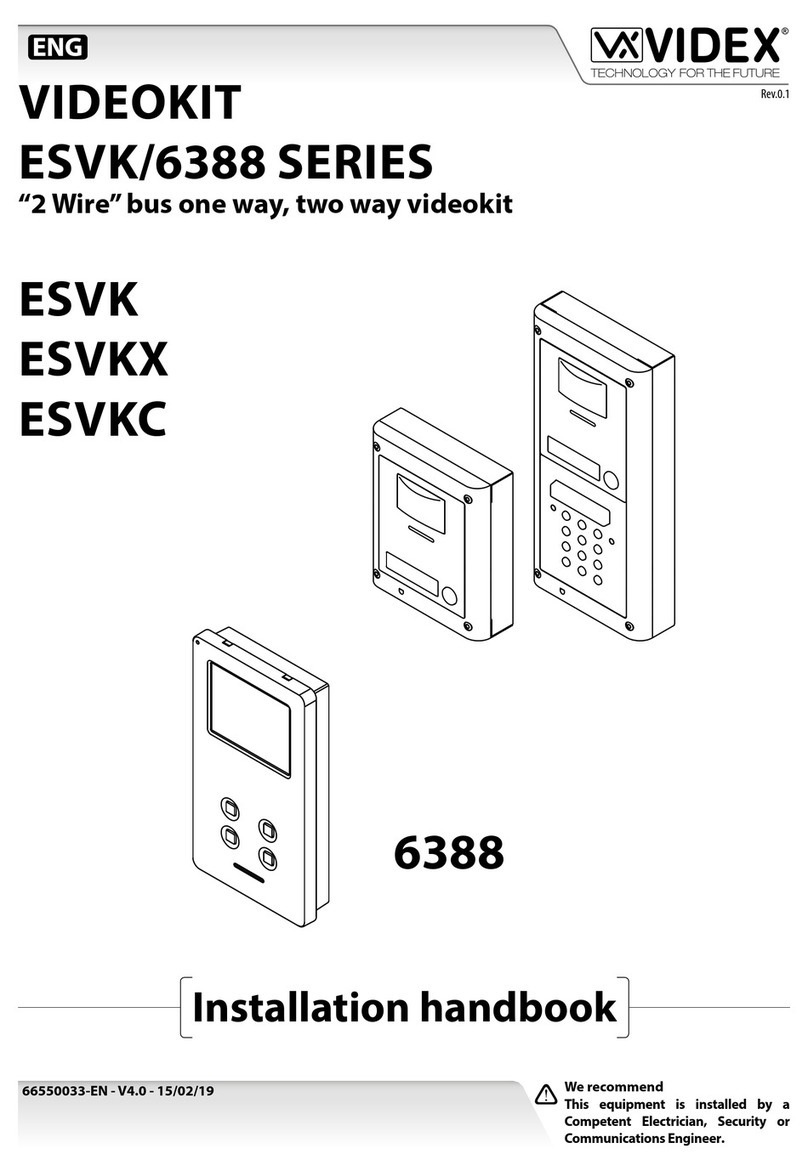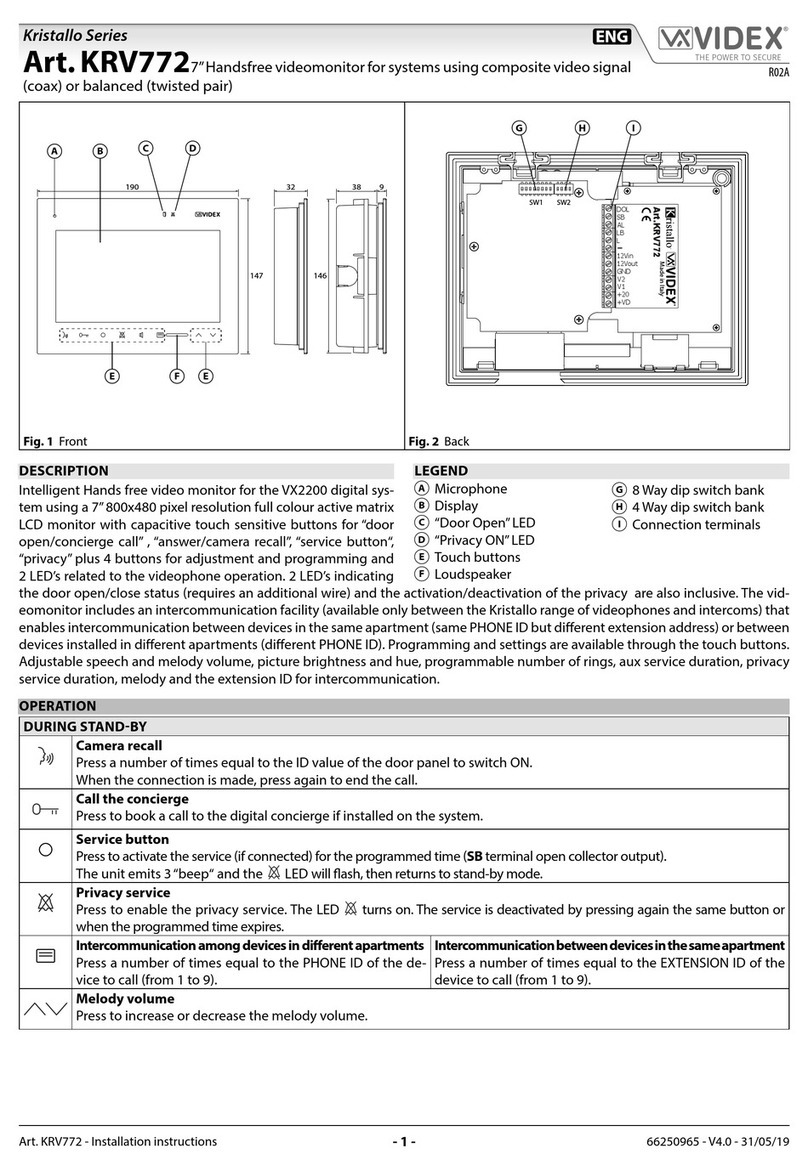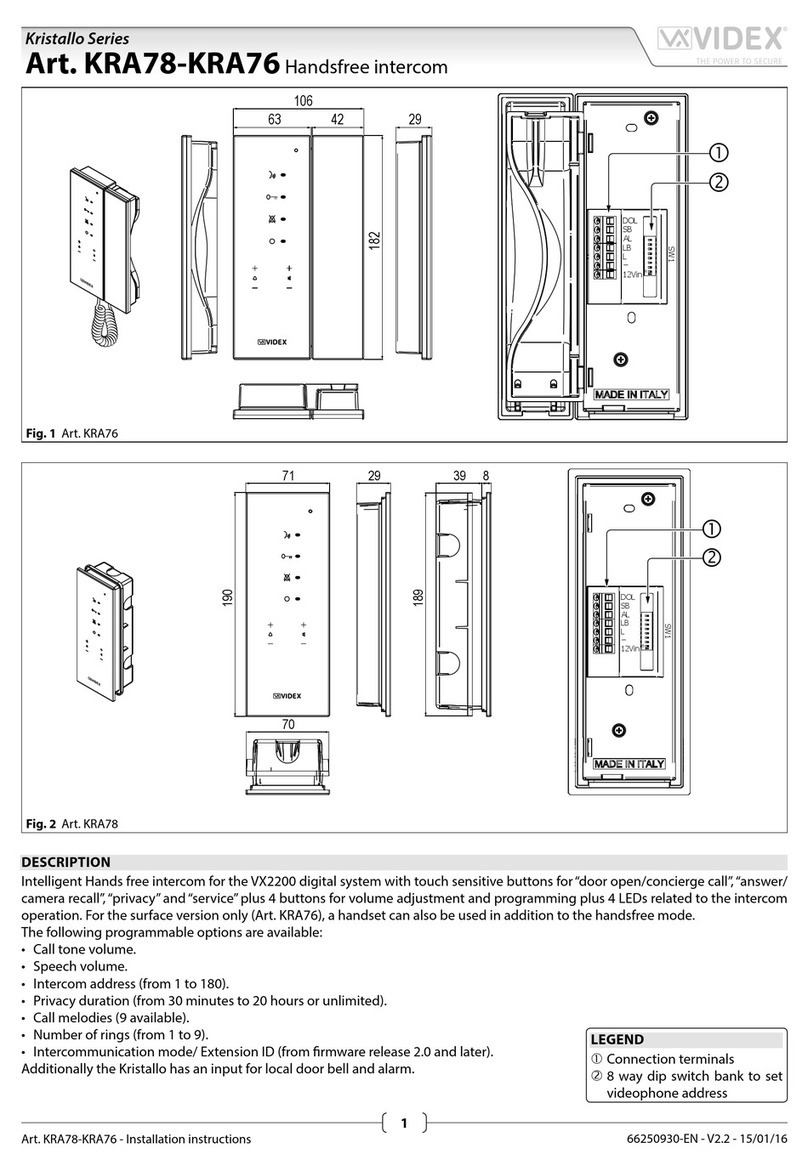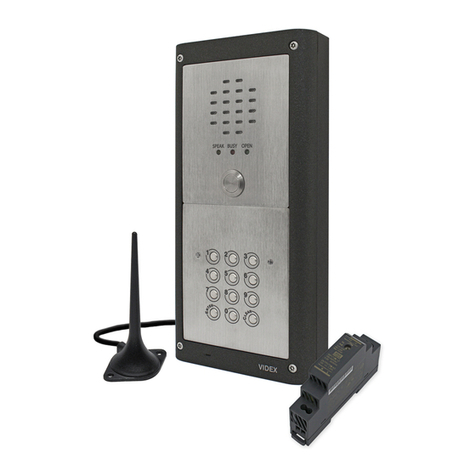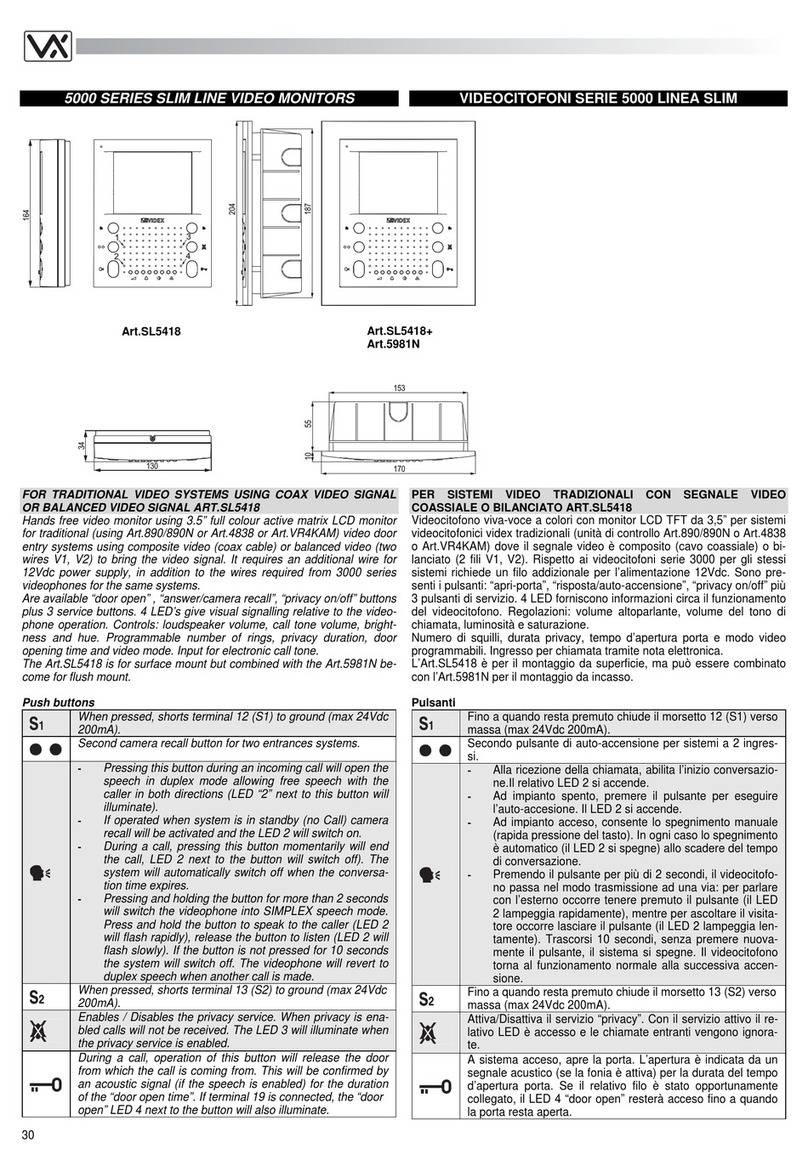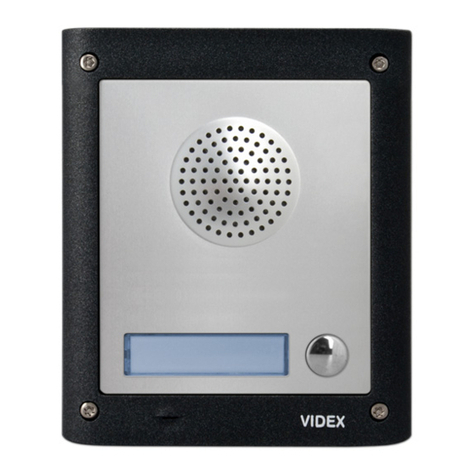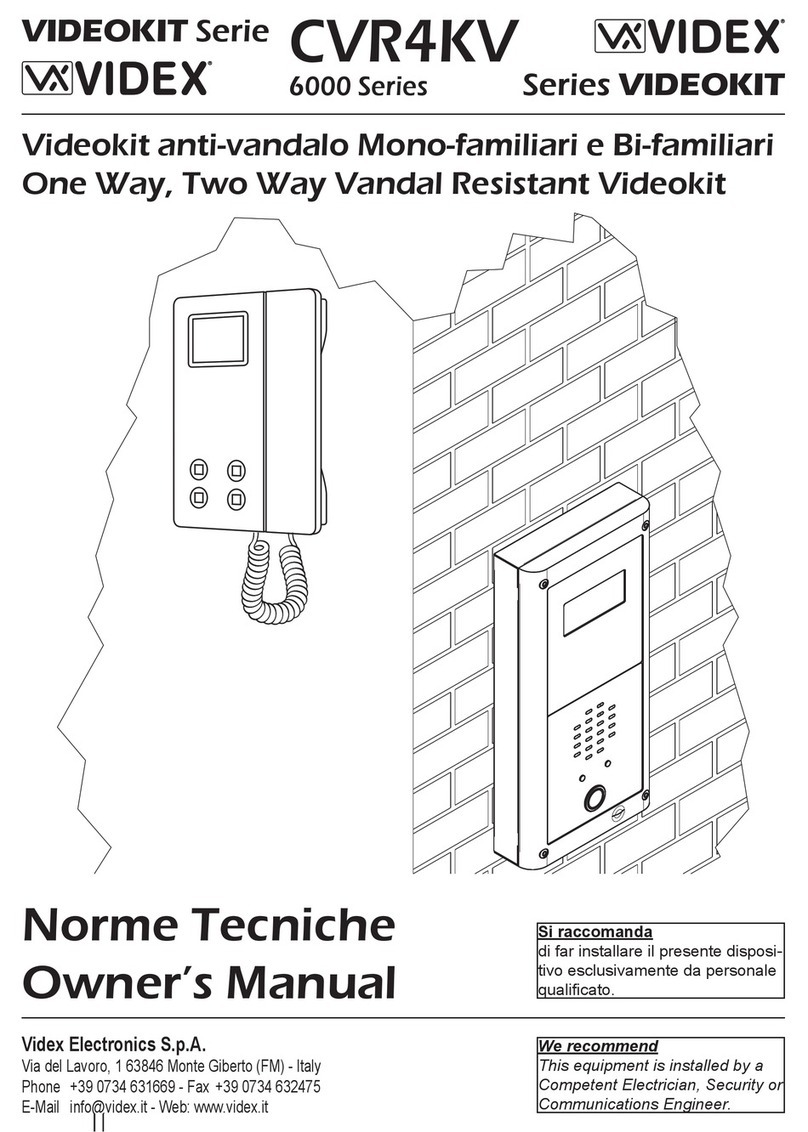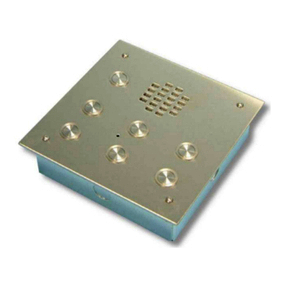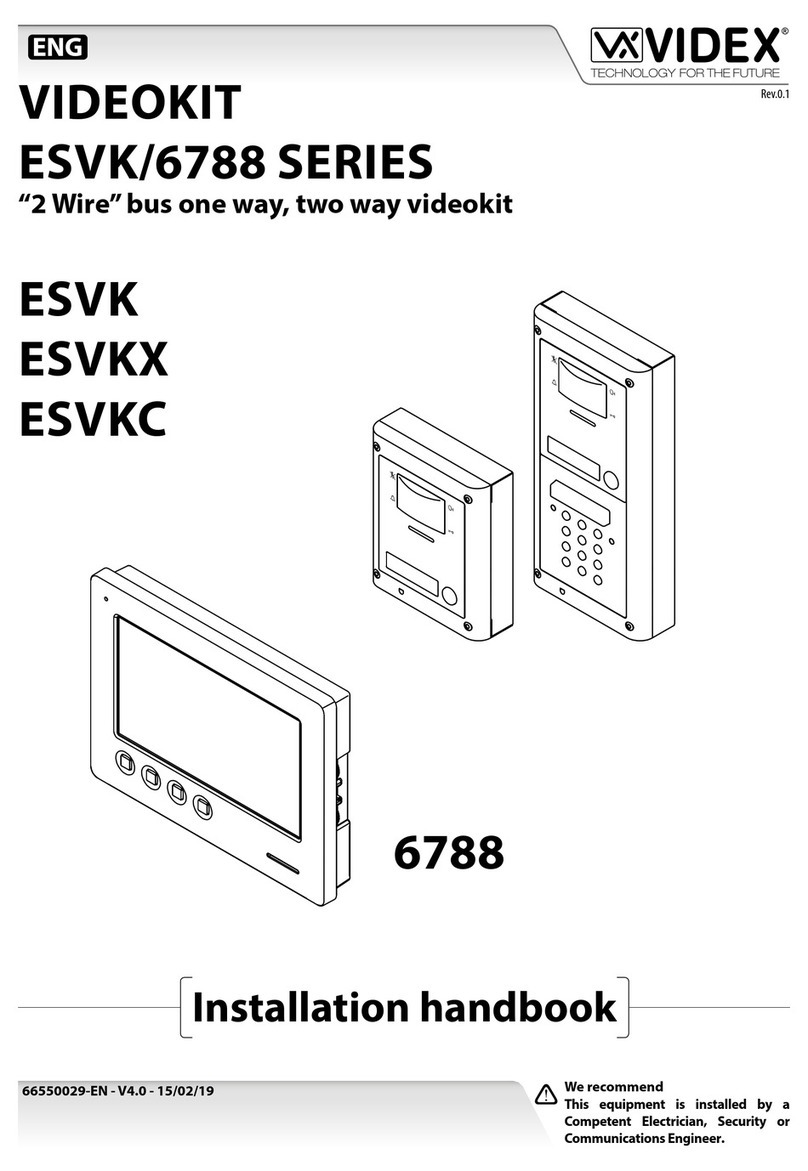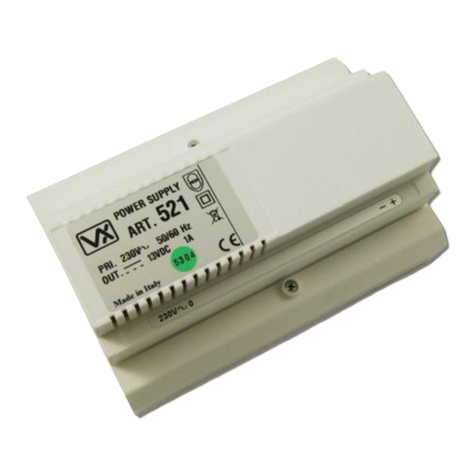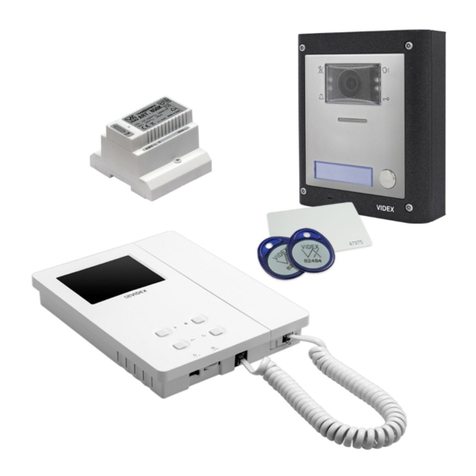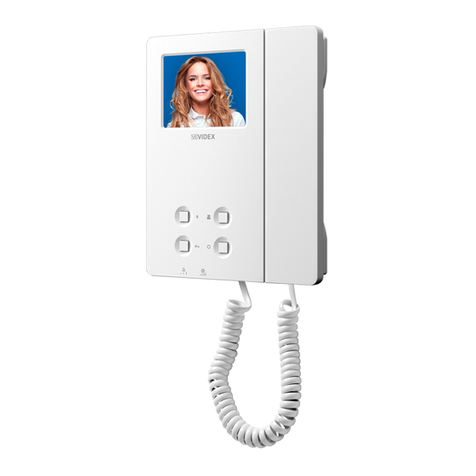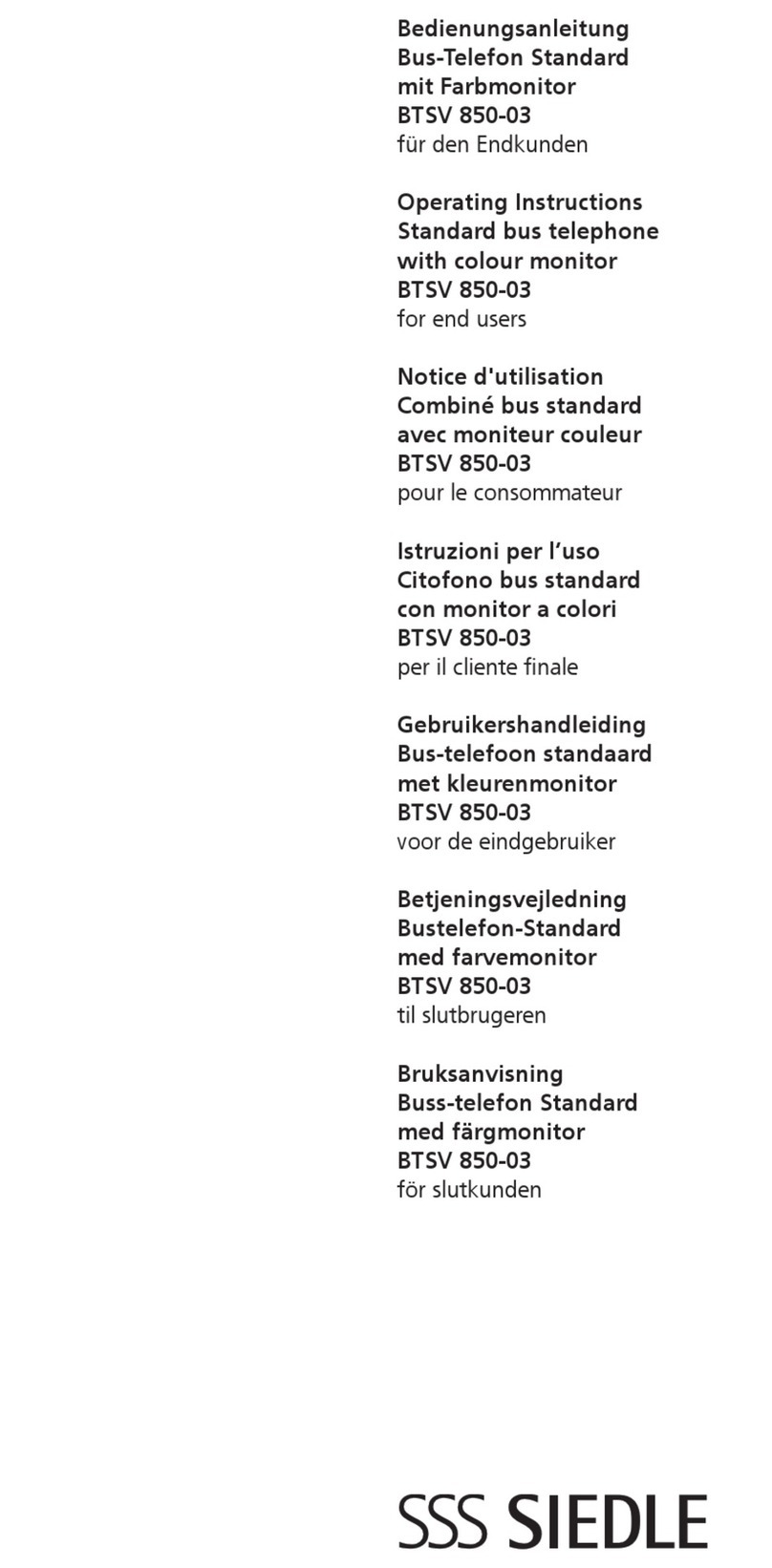equivalent one.
Check that the voltage between the terminals “ ” and “ ” of the speaker unit is between
16 and 20Vdc.
If the problem is not listed above, look at the following table.
!
!
!
!+-
RICERCA GUASTI TROUBLESHOOTING GUIDE
L’Art.4833 (posto esterno) non
riesce a far squillare l’interno (il
LED campana si accende per
circa 2 secondi):
The Art.4833 (door station) is not
able to call the extension (the
bell LED is switched on for 2
seconds):
Durante la conversazione non si
riesce ad aprire la porta, ma il
LED chiave dell’Art.4833 si
accende:
During the conversation it is not
possible to open the door but the
key LED (Art.4833) switches on
for the programmed time:
Rumore di fondo durante la
conversazione:
Noise over the speech line
during the conversation:
Non funziona il servizio di “auto-
accensione”:
Camera recall service does not
work:
Non funziona la chiamata
intercomunicante:
Intercommunicating call does not
work:
L’immagine mostrata dal monitor
del videocitofono è distorta o
riflessa:
The video shown on the monitor
is of a bad quality and the image
is distorted or double
Durante la conversazione non è
possibile aprire la porta:
During the conversation it is not
possible to open the door:
La fonia va dal posto esterno
verso l’interno ma non viceversa:
Speech only from outside to
inside:
Volume audio di conversazione
non adeguato:
Low volume of speech:
Non funziona la chiamata di
piano:
Local call does not work:
La chiamata dal posto esterno
funziona correttamente, ma alla
risposta cade la comunicazione:
External call works but when
answered the communication
fails:
!
!
!
Errato collegamento dei fili tra
l’Art.4833 e l’Art.3356,
verificare in particolare il filo
audio/dati “1”.
Sezione dei fili inadeguata.
L’indirizzo programmato sul
dip-switch dell’Art.3356 non è
corretto.
!
!
!
Wrong connection between
Art.4833 and 3356.
Wires section unsuitable.
Programmed videophone
address incorrect.
!
!
!
Ponticello mobile J2 in
posizione errata.
Fili della serratura collegati in
maniera errata.
Tipologia della serratura non
adatta.
!
!
!
Incorrect position of J2 jumper.
Electric lock wires
unconnected or in short.
Wrong electric lock type.
!
!
I 6 fili comuni sono stati
canalizzati insieme a cavi di
rete a 230 o 380Vac.
I fili di alimentazione 24Vac del
videocitofono Art.3356 sono
stati canalizzati insieme ai 6 fili
comuni per un tratto troppo
lungo.
!
!
6 common wires cabled
together with 230 or 380Vac
power lines.
6 common wires cabled
together with 24Vac
videophone power supply
wires.
!Premuto il tasto “auto-
accensione” per un numero di
volte diverso dall’ID del posto
esterno da accendere.
!Camera recall button pressed
for a number of times different
from the ID of the door station
to be switched on.
!Premuto il tasto “chiave” per
un numero di volte diverso
dall’indirizzo del videocitofono
da chiamare.
!”Key” button pressed for a
number of times different from
the videophone address value.
!
!
!
Segnali V1 e V2 non connessi,
scambiati o in corto circuito.
Gli switch del dip-switch a 2
vie del’ultimo videocitofono
non sono entrambi ad ON.
Se presente l’Art.316, linee
passanti V1 e V2 non chiuse.
!
!
!
V1,V2 signals unconnected,
exchanged or put in short.
The switches of the two way
dip-switch are not both in ON
position.
V1,V2 of the last Art.316 (if
present) not closed with 75
Ohm resistor.
!Sezione dei fili inadeguata. !Wires section unsuitable.
!Filo “ ” interrotto o in corto
circuito.
2!Wire “ ” broken or in short.2
!Trimmer di regolazione volume
dell’Art.4833 impostati in modo
non appropriato.
!Volume trimmers of Art.4833
require adjustment.
!Connessione errata o pulsante
difettoso.
!Wrong connection or call
button broken.
!Sezione dei fili inadeguata. !Wires section unsuitable.
!
!
!
Verificare la connessione dei 6
fili comuni e rimuovere
eventuali cortocircuiti.
Aumentare la sezione dei fili o
raddoppiarla utilizzandone altri
disponibili.
Verificare l’indirizzo del
videocitofono.
!
!
!
Check 6 common wires
connections especially wire “ ”
(speech line/data).
Use wires with a larger section
or double section using two
wires for each signal.
Check videophone address.
1
!
!
!
Verificare sull’Art.4833 la
posizione del ponticello J2.
Verificare il collegamento dei
fili.
Verificare che la tipologia di
alimentazione della serratura
(ac o dc) corrisponda
all’impostazione di J2.
!
!
!
Check J2 position on the
Art.4833.
Check wires connection.
Check that the electric lock
type (ac or dc) is suitable for
the J2 position chosen.
!
!
Isolare i 6 fili comuni da cavi di
rete o altri cavi ad alta
tensione.
Canalizzare i fili
d’alimentazione del
videocitofono separatamente
dai 6 fili comuni o insieme per
un tratto più breve.
!
!
Separate the 6 common wires
from the high voltages cables.
Separate the 6 common wires
from the two 24Vac wires or
cable them together only for a
short distance.
!Verificare il valore dell’ID del
posto esterno (1..4) e premere
il pulsante di “auto-
accensione” tante volte
quant’è il valore dell’ID.
!Check the ID (1..4) of the door
station to be recalled and
press the camera recall button
as many time as the ID value.
!Verificare la corretta
impostazione degli indirizzi dei
videocitofoni.
!Check the address of the
videophone you are calling
and try again.
!
!
!
Verificare continuità ed
isolamento dei fili V1,V2
Mettere ad on entrambi gli
switch.
Chiudere le linee passanti
V1,V2 verso massa con le
resistenze fornite a corredo
!
!
!
Check that the wires are not
broken and isolated.
Set both switches in ON
position.
Close through V1,V2 of the
Art.316 toward the ground with
provided resistors.
!Aumentare la sezione dei fili o
raddoppiarla utilizzandone altri
disponibili.
!Use wires with a larger section
or double section using two
wires for each signal.
!Controllare il collegamento del
filo “ ”.2
!Check connection of wire “ ”.2
!Regolare opportunamente i
trimmer fino a raggiungere il
livello di volume desiderato.
!Adjust the trimmers until the
required volume is reached.
!Controllare la connessione o
sostituire il pulsante.
!Check connection or replace
the button.
!Aumentare la sezione dei fili o
raddoppiarla utilizzandone altri
disponibili.
!Use wires with a larger section
or double section using two
wires for each signal.
Sintomo SymptomCausa CauseSoluzione Solution
FILI E SEZIONI SECTION OF WIRES
NOTA IMPORTANTE
Per le connessioni Video e quelle audio suggeriamo di utilizzare delle coppie di fili
intrecciati: una coppia per la linea video (morsetti “ ” e “ ”, segnali “ ” e “ ”) ed una
coppia per quella audio (morsetti “ ” e “ ”, segnali “ ” e “ ”).
2 fili da 1 mm
fino a 50m : tutti i fili da 0.35 mm .
da 50 a 100m : fili + e - da 0.75 mm ; tutti gli altri da 0.5 mm .
da 100 a 200m : fili + e - da 1.5 mm ; tutti gli altri da 0.75 mm .
fino a 50m : fili + e - da 0.5 mm ; tutti gli altri 0.35 mm .
da 50 a 100m : fili + e - da 1 mm ; tutti gli altri 0.5 mm .
da 100 a 200m : fili + e - da 2 mm ; tutti gli altri 0.75 mm .
4 5 V1 V2
12 12
Dal trasformatore al videocitofono max 20 mt.:
Dal videocitofono al posto esterno:
per VK4K, VKC4K
per il CVK4K
2
2
22
22
22
22
22
IMPORTANT NOTE
Video connections and Audio connections must be wired in twisted pair : pair the video
lines (terminals “ ” and “ ” signals “ ” and “ ”), pair the audio lines (terminals “ ” an

